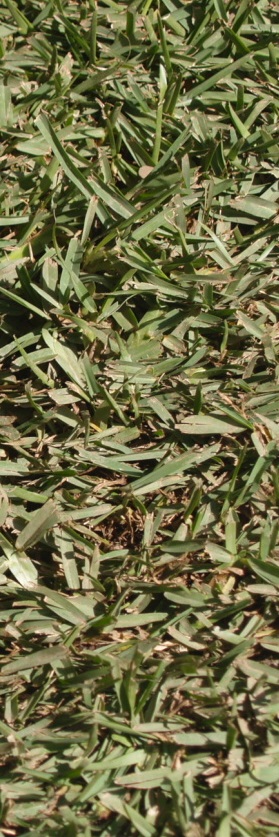Grasses for Warm Climates
 Amenity turf is widely used in warmer places, but if you want a lawn to grow well, remain health, and be hardy to wear and tear, you need to carefully choose the type of grass used. The following are some of those more widely grown under warmer conditions.
Amenity turf is widely used in warmer places, but if you want a lawn to grow well, remain health, and be hardy to wear and tear, you need to carefully choose the type of grass used. The following are some of those more widely grown under warmer conditions.
Couches
Cynodon dactylon (Bermuda-grass, Common or Green Couch, Indian Doub)
Vernation: folded; ligule: fringe of white hairs, 1 to 3 mm long; auricles: absent; Collar: continuous, narrow to broad, smooth, occasionally ciliate; blade: narrowed to a blunt tip, flattish, 2 to 4 mm wide, minutely hairy, stiff; Inflorescence: 3 to 6 spike clusters on slender culm; habit: erect yet mat forming with profuse runners and rhizomes. It is an extremely successful turf grass with many cultivars.
Cynodon transvalensis (African Bermudagrass)
Vernation: folded; ligule: fringe; auricles: absent; collar: continuous, narrow to broad, smooth, occasionally ciliate; Blade: narrow, flattish, hairy, stiff; Inflorescence: spikes in clusters on slender culm; habit: often a erect puffy grass with soft, bright, light green leaves. It spreads by short stolons and small fleshy rhizomes. It is one of the parents of many fine textured hybrid bermudagrass cultivars (e.g. ‘Tifgreen’ and ‘Tifdwarf’).
Digitaria didactyla (Queensland Blue Couch)
Vernation: rolled; ligule: membranous; auricle: absent; collar: continuous of yellowish green band; blade: usually flat, 3 mm wide with pointed tips; inflorescence: two tight racemes split on top of a long stalk; habit: stoloniferous turf with short blue green leaves.
Zoysia Grasses
Zoysia japonica (Japanese Lawn grass, Meyer Grass)
Vernation: rolled; ligule: 0.2 mm long fringe of hairs; auricles: absent; collar: continuous, broad, hairy on margins; Blade: flat, 2 to 4 mm wide, stiff, occasional hairs on upper leaf side; Inflorescence: short, spikelets laterally compressed; Habit: medium textured, slow and low growing turf that spreads by stolons and rhizomes.
Zoysia matrella (Manila Grass)
Vernation: rolled; ligule: 0.2 mm long fringe of hairs; auricles: absent; collar: continuous, broad, hairy on margins and at base; blade: 2 to 3 mm wide, stiff, hairy at base of blade on top, glabrous below, acute apex; inflorescence: short, spikelets laterally compressed; habit: fine textured, slow growing and dense. Not as cold tolerant as Japanese lawn grass.
Zoysia tenuifolia (Korean Velvet Grass, Mascarene grass)
Vernation: rolled; ligule: fringe of hairs; auricle: absent; collar: continuous, broad with hairy margins at base; blade: flat, fine, stiff, hairy leaves; inflorescence: short spikes; habit: this is the finest textured, densest and slowest growing of the Zoysia grasses. It is drought and heat hardy. Turf grass use limited to subtropical areas.
Carpet Grasses
Anoxopus affinis (Narrow Leaf Carpet Grass)
Vernation: folded; ligule: 1mm long fringe of hairs; auricle: absent; collar: continuous, narrow with hairs; blade: 4 to 8 mm wide, short hairs at tip; inflorescence: raceme of three rachis, spikelets only on one side of flattened rachis; habit: course textured, low growing turf spreading by seed or stolons.
Anoxopus compressus (Tropical Carpet Grass)
Vernation: folded; ligule: short with fringe of hairs; auricle: absent; collar: continuous, narrow, occasionally hairy; blade: 4 to 8 mm wide, occasionally hairy at base and apex margins, acute apex; inflorescence: 2 to 5 racemes on a thin stalk; habit: compressed stout culms with branching stolons. It is less cold hardy than A. affinis. Carpet grass forms a coarse textured, dense, low growing turf.
Paspalums
Paspalum dilatatum (Paspalum)
Vernation: rolled in the bud; ligule: bluntly triangular to 6 mm long, membranous; auricle: absent; collar: margins have spreading hairs; blade: glabrous with some long hairs near the collar, usually less than 20mm wide (3-12mm common); inflorescence: racemes are alternate (approx. 5-11) widely separated, lower racemes are longer than the upper ones; habit: This is a leafy, tufted perennial sod forming grass that has clusters of shoots arising from short rhizomes. It has thick fibrous roots.
Paspalum distichum (Mercer Grass)
Vernation: rolled in the bud; Ligule: membranous, about 0.5 mm long; auricle: absent; collar: 1mm long with hairs at the base; blades: soft, flat, dull green and mildly hairy, 3-12 cm long, and 2-6 mm wide; inflorescence: 2 paired, opposite, compound, racemes 2-8cm long initially flat but spreading later; Fast growing grass of wet areas – can become weedy.
Paspalum vaginatum (Salt Water Couch)
Vernation: folded - conduplicate; ligule: 0.5-1.5mm long; Blade: 7mm wide; auricle: absent; collar: Blades: sheathed, pilose on the margins and towards the apex but smooth otherwise; inflorescence: 2 usually shortly pedunculate, erect racemes 1.5-7.5cm long, pedicellate, solitary 2.5 -4.5cm spikelets in 2 rows and a fertile floret 2.2 – 3.5mm long. This is a stoloniferous and rhizomatous perennial to 0.5 m high; stolons to 5 m long.
Paspalum notatum (Bahia Grass)
Vernation: rolled; ligule: membranous; auricle: absent; collar: broad and continuous; blades: lightly folded at the base and usually hairless, coarse, light to medium green; inflorescence: a panicle, usually comprising two terminal racemes; habit: sward forming perennial grass that is variable in its habit. It has fibrous rhizome-like stolons, to 5mm in diameter. Shoots appear from the base of deep fibrous roots.
OTHER IMPORTANT GRASSES
Pennisetum clandestinum (Kikuyu Grass)
Vernation: folded; ligule: fringe of hairs 2mm long; auricles: absent; collar: broad and continuous; blade: pubescent and somewhat flattened near the apex; inflorescence: dense, bristly, tightly contracted panicle; habit: low tough spreading turf with leafy, thick creeping rhizomes and stolons.
Stenotaphrum secundatum (Buffalo Grass or St Augustine Grass)
Vernation: folded; ligule: fringe of hairs 0.3 mm long; auricles: absent;
collar: continuous to form a short stalk at the base of the blade; blade: usually flat, 4 to 10 mm wide, smooth on both surfaces with a blunt end; Inflorescence: short flowering culm bearing racemes; habit: Leaves clustering at each node with long creeping stolons.

You may also be interested in....